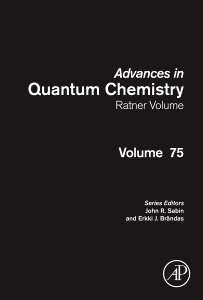Advances in Quantum Chemistry: Ratner Volume
Directeurs de Collection : Sabin John R., Brändas Erkki J.

Advances in Quantum Chemistry, Volume 75 presents work and reviews of current progress in computational quantum mechanics as presented by some of the world?s leading experts. This latest release includes chapters on Mean-Field Methods for Time-Dependent Quantum Dynamics of Many-Atom Systems, Electron?Ion Impact Energy Transfer in Nanoplasmas of Coulomb Exploding Clusters, Molecular Properties of Sandwiched Molecules Between Electrodes and Nanoparticles, Criterion for the Validity of D'Alembert's Equations of Motion, and A Time-Dependent Density Functional Theory Study of the Impact of Ligand Passivation on the Plasmonic Behavior of Ag Nanoclusters.
1. Mean-Field Methods for Time-Dependent Quantum Dynamics of Many-Atom Systems Barak Hirshberg and R. Benny Gerber 2. Electron–Ion Impact Energy Transfer in Nanoplasmas of Coulomb Exploding Clusters Isidore Last and Joshua Jortner 3. Molecular Properties of Sandwiched Molecules Between Electrodes and Nanoparticles Stine T. Olsen, Asbjørn Bols, Thorsten Hansen and Kurt V. Mikkelsen 4. Criterion for the Validity of D'Alembert's Equations of Motion John W. Perram 5. A Time-Dependent Density Functional Theory Study of the Impact of Ligand Passivation on the Plasmonic Behavior of Ag Nanoclusters Adam P. Ashwell, Mark A. Ratner and George C. Schatz 6. Switching Activity of Allosteric Modulators Controlled by a Cluster of Residues Forming a Pressure Point in the mGluR5 GPCR: A Computational Investigation Michael Sabio and Sid Topiol 7. Singlet Fission: Optimization of Chromophore Dimer Geometry Eric A. Buchanan, Zdenek Havlas and Josef Michl 8. Continuum Contributions to Dipole Oscillator-Strength Sum Rules for Hydrogen in Finite Basis Sets Jens Oddershede, John F. Ogilvie, Stephan P.A. Sauer and John R. Sabin 9. Features of Nearly Spherical Electronic Systems Jan Linderberg
Researchers and post-graduates in quantum chemistry and physics from molecular to solid state applications.
Sabin’s research interest is in the theoretical description of the interaction of fast charged baryon projectiles with atomic and molecular targets, both as neutrals and ions. In this work, he uses molecular quantum mechanics to describe such interactions. In particular, he is interested in the mechanism of absorption of the projectile’s mechanical energy by the target, where it is mostly converted to electronic energy, which is measured by the target’s mean excitation energy. He has written some 250 articles in this and related fields.
Sabin is editor of Advances in Quantum Chemistry and has been editor of the International Journal of Quantum Chemistry. He has edited some 90 volumes and proceedings.
Erkki Brändas was born in Tampere, Finland in July1940 and was, as a Finnish war child, transported to Sweden in February 1942, finally adopted by his Swedish parents and given Swedish citizenship in 1947. He received his FL (PhD) in 1969 and Doctor of Philosophy (habilitation) in 1972, both at Uppsala University. Except for guest professorships in USA, Germany, Israel, he spent his professional career in Uppsala employed as Assistant- Associate- and Full Professor from 1975 until retirement in 2007. In addition to serving as chairman of the department of Quantum Chemistry, he was appointed Executive Director of the Uppsala Graduate School Advanced Instrumentation and Measurement supervising the doctoral education of 35 PhD’s from 1997-2007. He has served
- Presents reports on current work in molecular and atomic quantum mechanics
- Contains work reported by many of the best scientists in the field
- Dedicated to one of the great practitioners in the field, Mark A. Ratner
Date de parution : 05-2017
Ouvrage de 282 p.
15x22.8 cm
Thèmes d’Advances in Quantum Chemistry: Ratner Volume :
Mots-clés :
Ab initio potentials; Ab initio quantum chemistry; AICSP; Allosteric modulator; Asymptotic propagator; Classical separable potentials; Coulomb explosion; Dirac-Fermi-Thomas model; Docking; Electron-spi1ion impact; Exchange; GPCR; HOMO/LUMO model; Inhomogeneous electron gas; Ligand-protected; Local maxima in six dimensions; mGluR; Mixed quantum-classical methods; MPEP; NAM; Nanocluster; Nanoplasmas; Optical response; PAM; Photophysics; Plasmon; Quantum dynamics; SBDD; Singlet fission; Spherical geometry; Time-dependent density functional theory; Time-dependent mean-field methods; Time-dependent self-consistent field; Ultraintense lasers; Vibrational self-consistent field; Vibrational spectroscopy; X-rayspi1 structure



